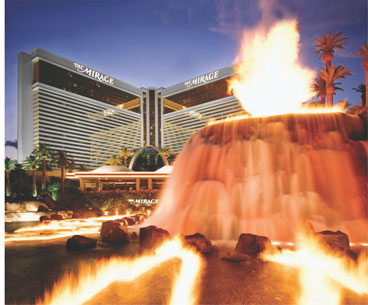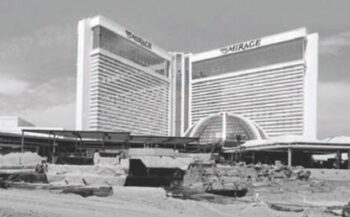
We’ve all seen it in movies. A character crawls across a parched desert toward the sweet reprieve of the oasis ahead. As he inches closer, the promised paradise disappears. It was always an apparition. A mirage.
Soon, Vegas Strip-goers will experience their own version of this trope (without the thirsty desert-crawling element). On July 17, the Mirage, a beloved Vegas mainstay, will fade into the annals of Vegas history. Hard Rock International will reopen the property in 2027 following renovations.
In celebration of the Mirage’s legacy, let’s look back at the resort’s incredible impact on Las Vegas hospitality.
Customer-Centric
The pre-Mirage Vegas experience was mired by tension between employees and management. Union members and managers were treated very differently.
In 2021, Andrew Klebanow, principal at Klebanow Consulting, and Arte Nathan, former Mirage HR vice president, now president of Strategic Development Worldwide, wrote the following for Global Gaming Business:
“It was common practice for managers, supervisors and exempt (non-union) employees to take their meals in the casino buffet or coffee shop, while unionized employees ate their meals in the employee dining room, often called ‘the Helps Hall.’ The latter dining experience, rarely memorable, fueled a caustic employee culture at many properties that negatively affected customer service.”
Unsurprisingly, the poorly treated employees weren’t exactly keen on offering a five-star customer experience. But the Mirage was a harbinger of change for Vegas hospitality workers. Steve Wynn assembled a crack team of heavy-hitters: Bobby Baldwin would lead the charge as president, Doug Pool was tapped as chief financial officer, and Arte Nathan helmed the human resources team.
Klebanow and Nathan continue: “The first thing (Wynn) told them was that the Mirage would never be about the building, but about the employees and their commitment to the promise of excellence.”
When hiring began, the Mirage sought go-getters, with the mantra, “Hire for attitude and train for skills.”
The relationship with the union was also a top priority. Wynn asked his team to negotiate terms that would bridge the gap between union workers and managerial staff. The reformed agreement “set the course for years of labor peace for the company.”
With customer service locked in as the core value of the Mirage, the property’s casino style was taking shape. To treat customers well, you have to have customers. The Mirage drew them with revolutionary design concepts and architecture that redefined Vegas resorts.
Rebuilding the Vegas Experience
 The physical elements of the Mirage—the entire complex—were built to facilitate the top-notch customer service Wynn was aiming for.
The physical elements of the Mirage—the entire complex—were built to facilitate the top-notch customer service Wynn was aiming for.
By the numbers, the Mirage was impressive for its time. As the first new Vegas hotel in 15 years, it upped the game, with 3,044 rooms, 24 guest elevators, and a total price tag of $630 million. The Mirage was a spectacle when it opened in 1989, ushering in a new era of fresh and flashy properties that would take over the Strip in the ’90s.
The structure would serve as a blueprint for many hotels to come. From GGB again: “The Y-shaped hotel tower and 24-elevator core limited the distance guests would have to walk to their rooms. That design can now be found in integrated resorts throughout the world.”
Six staff-only elevators and back-of-house transit corridors, which were disappointingly not called “secret passages,” streamlined the property’s service.
With function handled, the Mirage team could shift focus to form. Roger Thomas—now executive vice president of design for Wynn Design and Development—was an “integral part of the Mirage team,” wrote Oliver Lovat for GGB in 2019.
“Unlike contemporary casinos seeking to build points of entry near the sidewalk, hoping to lure passing pedestrians, the Mirage was set back from the Strip, inspired by (developer Jay) Sarno’s decision to extend the resort experience to street level. Archways over the drive deliberately delineated the fantastic from the mundane. The aforementioned white waterfalls, statues and lush landscaping combined to form a grand entrance and sense of arrival at an unmistakable destination.”
Like its mythical desert oasis namesake, the Mirage became a beacon for potential casino-goers and hotel guests. Its positioning gave it a unique architectural allure.
 That ethos started from the second a guest approached the property—whether by car, taxi or foot. The Mirage welcomed guests with a wooden bridge surrounded by a tropical rainforest beyond a protective dome.
That ethos started from the second a guest approached the property—whether by car, taxi or foot. The Mirage welcomed guests with a wooden bridge surrounded by a tropical rainforest beyond a protective dome.
As Lovat wrote: “The sound of the waterfall and enveloping winding trees signaled a statement of arrival, an Instagram moment in the Polaroid age.”
This element was completely intentional. Designers working on the Mirage didn’t want customers walking through the doors and being bombarded with the standard Vegas fare—ringing, dinging slots, rolling dice, flashy signage, the works. Instead, Mirage patrons would be eased into it. The team “sought to convey the essence of a resort, setting the tone for the customer journey ahead.”
This design approach influenced many of the resort properties that followed. The Venetian is just one of many hotels that created an extravagant entry experience. The Bellagio, which opened in 1998, has since played host to any number of flamboyant entrance art displays.
Amenities & Entertainment
Core to the guest experience at any Vegas hotel is the entertainment on offer, and the Mirage had a hand in shaping that outlook, too.
Before the Mirage, many Vegas theaters were pay-to-play. The big spenders could get the best seats. Here’s Klebanow and Nathan again:
“Casinos had long used entertainment as a marketing tool, with headline entertainment as a way to entice premium players to visit. Prior to the Mirage, casino showrooms were designed in a similar manner. Booths reserved for VIPs were arranged in a series of horseshoes around the stage, and narrow rectangular tables below each tier perpendicular to the stage were devoted to general admission seating.
“Guests were obligated to tip their way to a reasonably good seat, and those who didn’t often found the location and sightlines to the stage less than ideal.”
Then came the Mirage with its headlining show: magician-entertainers Siegfried and Roy, famous for their big-cat show, with white lions and tigers. The 2,000-seat venue took its cues from Broadway, trying for the classic “not a bad seat in the house” approach. It was a welcome reprieve for customers who wanted glamorous entertainment sans exorbitant pricing.

Siegfried and Roy
“Guests could reserve their seats from a map with prices clearly displayed, rather than be beholden to the maître d’,” wrote Klebanow and Nathan. “A state-of-the-art ticketing system supported this endeavor. This style of showroom ticketing is common practice today, but not so in 1989.”
Entertainment and eye-catching displays peppered the Mirage. Its trademark volcano would intermittently spew lava in front of the property, an attention-grabbing spectacle of the type that is now practically required for Vegas properties.
An aquarium further cemented the Mirage’s tropical paradise aesthetic, hosting more than 1,000 types of fish skimming through the water behind reception.
Perhaps the most interesting feature (in a sea of admittedly amazing features) was the pool area, which abutted the tiger habitat. The creatures were part of the revolutionary Siegfried and Roy show, but they were a draw outside of the performance, too. Klebanow and Nathan once more:
“The tiger habitat became an interactive attraction that proved wildly popular with guests—so much so that Wynn then designed and built a dolphin habitat managed and run by aquatic and marine professionals. The centerpiece of this new exhibit was a set of three pools that featured bottlenose dolphins in a nature-like setting.”
What Remains, and What’s Next
The name Mirage might suggest a hallucination or a feverish dream, but the property was no illusion, and its legacy will live on. The Mirage was the lifeblood of Las Vegas reinvention in the ’90s, heralding changes in amenities and attractions that would eventually become standard.
When patrons walk the halls of any Strip casino, they’re bound to encounter the Mirage legacy. Flashy art displays, themed entryways, theaters with reasonable seating, flagship shows, streamlined layouts—Vegas-goers have the Mirage to thank for these elements, and many more.
 Mirage ownership has now changed hands twice. MGM bought the property and its corresponding holding company from Wynn in 2000. Hard Rock bought the rights to casino operations in 2021 for $1.075 billion.
Mirage ownership has now changed hands twice. MGM bought the property and its corresponding holding company from Wynn in 2000. Hard Rock bought the rights to casino operations in 2021 for $1.075 billion.
As the end nears, an important chapter of the Vegas story comes to an end. But new beginnings are afoot, and Hard Rock’s redesign will deploy many of the factors the Mirage originally made famous.
Following the closure, Hard Rock International will begin a large-scale renovation. The Mirage’s volcano will be demolished, but its ability to capture the attention of guests from afar will live on in a 700-foot-tall guitar-shaped hotel tower, far outdoing Hard Rock’s 450-foot counterpart tower in Hollywood, Florida. The volcano teardown announcement was met with a lot of public pushback, but the efforts to preserve it made no headway.
The final day for Mirage hotel room bookings is July 14. Reservations for rooms and shows after July 14 will result in cancellations and guest refunds.
Cirque Du Soleil’s Love will run its final performance on July 17, capping off a staggering 18-year run. The host theater will be torn down as part of the renovations.
Hard Rock Hotel & Casino Las Vegas will upgrade the theater experience to include 5,000 seats. Dining options will also expand to include more than 20 new restaurants and food stops.
Employees of the Mirage, who formed the basis of the hotel’s landmark approach to the Vegas experience, are expected to be laid off, with Hard Rock paying an estimated $80 million in severance. Some employees will be offered relocation to other Hard Rock properties in Florida, Indiana, Ohio and Virginia.
Members of Culinary Union 226 renegotiated contracts with the Mirage last year. The revised agreement included contingencies for the imminent closure. Members “will receive $2,000 per year of service, or lesser amounts should they opt to keep their seniority rights,” as reported by GGB.
The property is expected to reopen as Hard Rock Hotel & Casino Las Vegas in 2027, though that should be taken with a grain of salt. Delays are known to plague such projects, so the years ahead may bring complications.
For now, we pour one for the Mirage, one of the most impactful and revolutionary properties to grace the Las Vegas Strip. It will be dearly missed.





